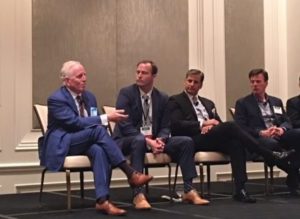
E-Commerce, Business Relocation Feed Growth in Las Vegas Industrial Market
Wednesday, May 2nd 2018
LAS VEGAS — The Las Vegas industrial market was built on supporting the city’s tourism and hospitality industry, which brings in nearly $60 billion per year, according to a study by Applied Analytics. But in recent years, the segment has evolved and grown thanks to the emergence of e-commerce and the harsh market conditions of nearby Southern California.
A panel at the InterFace Las Vegas Industrial conference, held at the Four Seasons Hotel in Las Vegas on April 24, brought together eight regional developers and owners to discuss the changing state of the Las Vegas industrial market in 2018.
Included on the panel were Michael Dermody, CEO at Dermody Properties; Taylor Arnett, vice president at CapRock Partners; Kevin Higgins, senior vice president and partner at CBRE; Doug Roberts, partner at Panattoni Development Co.; Fritz Wyler, managing director at Prologis; Rod Martin, director of development at Majestic Realty Co.; and Jordan Schnitzer, president at Harsch Investment Properties. Phil Ralston, president at American Nevada Co, moderated the panel.
“Historically, the Southwest [Las Vegas] submarket has brought a premium in rents [compared] to what you see in the other submarkets, and 80 percent of the tenant base there is doing business on the strip,” said Martin. “Over the last five years, the North Las Vegas submarket has become the largest single submarket in regards to square footage. Really, the switch was flipped with the emergence of e-commerce.”
Traditionally, the Las Vegas industrial market has been based on serving the roughly 200,000 people staying on the Las Vegas strip, he explained. But now, much of the gaming and resort activity, which drove the market through the last cycle, is being replaced by infrastructure supporting the booming e-commerce industry.
The North Las Vegas submarket currently has an inventory of 40.2 million square feet, compared with 30.4 million square feet in Southwest Las Vegas, according to CoStar Group.
Las Vegas has become a fulfillment hub for Southern California, which can be reached in a one-day drive and is a regional center for merchandise returns over much of the Western United States.
“With the change in e-commerce, this is a market where you could count on one hand the number of buildings over 500,000 square feet during the last [development] cycle,” said Wyler. “Now several of us here are focused on constructing buildings that can be 500,000 to 800,000 square feet.”
California Flight
Many companies are moving their operations away from Southern California, where the cost of doing business has become too expensive, and have opened up shop in Las Vegas, prompting the development of large industrial properties in the North Las Vegas submarket.
“I can point to five or six different deals that I’ve seen where tenants have come out of the California portfolio and moved here,” said Wyler. “That’s going to continue as California is only getting more expensive.”
“From a developer and investor standpoint, vacancy rates in Orange County, California, for example, have been below 2 percent for the past five years,” said Arnett. “Land prices there for industrial product are approaching $60 per square foot.”
The competition in Southern California has driven many tenants to Las Vegas, he added. Industrial vacancy rates in Vegas are at the lowest point ever despite the surplus of new product coming online. Rents and values in Las Vegas are still below peak value.
But with tremendous growth in the most recent economic cycle for the Las Vegas industrial market, there is concern over how long it can last. Moderator Phil Ralston posed the question to the group of what “inning” they think the market is in and if Las Vegas is a boom or bust market.
“I look back at some of the decisions I made in 2006-2007. You start to hear some of the same buzzwords, and that’s what’s scary,” said Schnitzer. “We all know this can’t continue to go up forever.”
“At the same time, in this market we’ve never seen this kind of growth, diversification and balance,” continued Schnitzer. “We are in the eighth inning, but what you just don’t know is how long that is.”
“I think it’s the seventh inning stretch and I don’t know how long that stretch is going to be,” said Higgins. “In the last turnaround, we were in every food group imaginable developing — whether it was freestanding buildings, small flex, mid-bay, you name it. That was the real tip of the iceberg and kind of the beginning of the end.
“What’s different about Las Vegas now is that people really underestimate the power of that tidal wave coming from Southern California to us.”

From left to right: Michael Dermody, CEO at Dermody Properties; Taylor Arnett, vice president at CapRock Partners; Kevin Higgins, senior vice president and partner at CBRE; and Doug Roberts, partner at Panattoni Development Co. participate in a panel at the Interface Las Vegas Industrial conference April 24, 2018.
